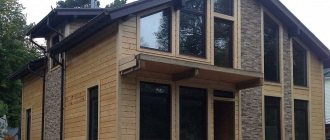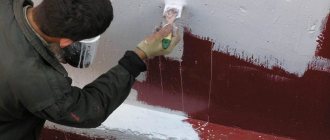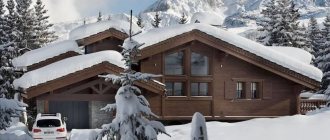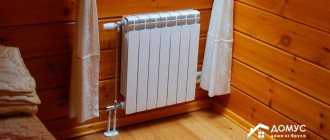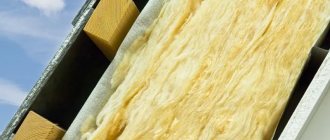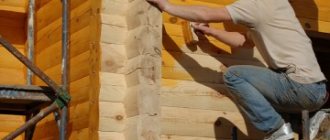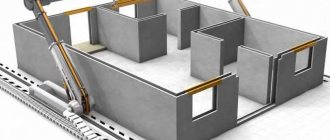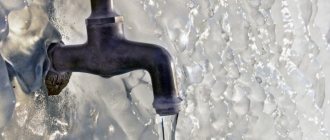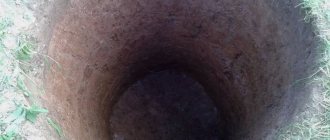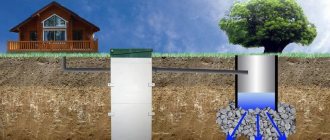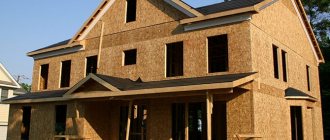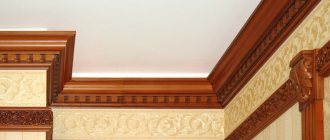A typical picture of the past from books: autumn, rain, dripping from the roof... A strange situation, isn’t it? But could it have been different if, until relatively recently, roofs were waterproofed exclusively with parchment and short-lived roofing felt. If at all they used anything other than raw wood. But today, materials for roof waterproofing are so different and in such a large number of types that it is difficult to understand them.
Should I buy a roll membrane for my own bathhouse under construction, or is it better to use a regular film, or is it even better to use something new and unusual? But now we will help you figure this out: what and for what roofs are produced today.
Types of waterproofing
The most common types of roof waterproofing are:
- Pasting . Previously, glassine and roofing felt were used. However, today they have been replaced by polymer-based materials. The main advantage of bitumen and roll waterproofing materials is that they can cover the roof of almost any configuration.
- Painting room This waterproofing is created by applying a liquid, viscous substance to the base of a concrete roof. As a result, a fairly strong continuous layer approximately 2 millimeters thick is formed. There are no seams or joints in this coating. Therefore, it perfectly protects the roof structure from water. Polyurethane mastics can be one-component or two-component.
- Waterproofing with sheet material. This method is usually used in conditions with high force impacts. This type of waterproofing is created as follows: the roof is covered with steel sheets welded to each other. The result is a continuous waterproof coating. The cheapest option is waterproofing made from plastic materials. In this case, the materials are welded together using hot air.
- Film waterproofing. Used on pitched roofs. Polypropylene film does not absorb water, does not rot and has a long service life. Proper installation of the film in this case plays a very important role. It is necessary to position the waterproofing film correctly. It is mounted horizontally with an overlap.
Liquid waterproofing is rightfully considered a cost-effective option. This type of roof waterproofing is manufactured in factories and does not require additional costs.
Mastic is a viscous adhesive composition containing special additives. Due to these additives, different parts of the base are connected to each other. The surface is protected from corrosion by a thick layer of dispersion fillers. The mastic also completely fills the recesses, irregularities and cracks, thus forming a complete seal.
It should be noted that mastic waterproofing in its properties is very similar to an adhesive composition. However, mastic is more viscous due to chemical reactions that occur when the surface is heated.
Types of liquid waterproofing:
- Polyurethane mastic. It is based on polyurethane resin. This type of mastic sticks very well. Polyurethane mastic can be used to insulate iron, wood, concrete and plaster. This is very important, since almost any roof contains elements made of different materials, for example, a concrete base or metal exhaust pipes. Waterproofing made with this material will prevent leaks for a long time. It is used in places where water stagnates and in strong, complex units. A freshly applied layer of mastic must be sprinkled with a layer of quartz sand. This will increase the protective properties of the coating. The viscous, viscous composition is applied using a hydraulic sprayer or roller. Self-leveling roofing made from mastic can be of any color.
- Bitumen mastic. This material is used on pitched roofs where there are no places where moisture stagnates. One type of bitumen mastic is liquid rubber. It is often used when waterproofing the roofs of industrial buildings.
- Polyurea. This is a two-component coating based on polyurethane resins. To apply self-leveling roofing, a special spraying installation is used. This unit heats the components and performs high precision mixing. The main advantages of this material: high precision of application and very fast polymerization.
The advantages of the material include:
- No seams;
- Chemical resistance (not afraid of corrosion, oxidation, ultraviolet rays);
- Elasticity;
- Maintainability.
It should be noted that mastics (except liquid rubber) cannot be applied to a wet base. This is their main drawback.
Is insulation required for sandwich panel coverings?
Despite the fact that sandwich panels are produced completely protected from all external influences, the roof laid with them also requires a set of waterproofing works. The following elements need to be protected:
- places where the foam of the roof meets the attic or dormer windows;
- flashings , gussets;
- panel locks;
- seams of the outer surface.
These elements are protected using double-sided self-adhesive tapes or sealant. Proper waterproofing will allow a sandwich panel roof to last for at least 30 years.
Using sealant, it is necessary to isolate the connecting seams of sandwich panels from water. Source prakard.com
Roofing membranes
Membrane roofing is a solid waterproofing sheet, which consists of sheets hermetically joined to each other. The thickness of the canvas is 0.8 - 2 millimeters, length - up to 60 meters, width 0.9 to 15 meters.
Polymer membranes have diffusion properties. In other words, no moisture forms underneath them. It is advisable to carry out waterproofing with this material in straight open areas containing a minimum number of roof structures.
If there are a large number of elevator shafts, pipes and skylights, it is better to use mastic waterproofing.
The following types of roofing membranes exist:
- EPDM. The basis of these materials is synthetic rubber. It also includes fiberglass, which increases the strength of the material. The connection of classic canvases is carried out using the adhesive method. Composite membranes are joined by hot air welding, and new generation materials are joined by vulcanization;
- PVC membranes. It is a glass fiber reinforced plasticized polyvinyl chloride. It should be noted that the latest generation of PVC membranes is resistant to solvents, oils and bitumen. However, over time, the elastic properties of this material become worse;
- TPO membranes. The basis of this material is thermoplastic olefins. Membranes of this type are reinforced with polyester mesh or fiberglass, which have increased wear resistance and high puncture resistance. TPO membranes are attached to the roof using adhesive, ballast or mechanical methods (using self-tapping screws).
Stekloizol
This type of roof waterproofing is made using a unique technology. A binder containing bitumen is applied to the base on both sides.
The outer side of the material is covered with coarse-grained topping. This creates a protective layer. The material has the following advantages:
- High moisture evaporation;
- UV resistance;
- Resistance to environmental influences;
- Resistance to mechanical damage.
It should be noted that this material can be laid at low ambient temperatures. Stekloizol will not lose its elasticity. The basis of this waterproofing material is fiberglass or frame fiberglass.
What is a metal roof and its structural features?
Metal tiles are a material intended for the construction of high-quality and reliable roofing coverings. This roofing material is supplied in the form of sheets of thin steel, aluminum or copper coated with a polymer protective composition. Metal roofing is very similar to natural tiles, but at the same time it differs from it in its characteristics. Metal tiles are used as a covering for pitched roofs with a minimum slope angle of 14°.
Main characteristics of metal roofing:
- Lightness – The specific weight of 1 m² of metal tiles is plus or minus 5 kg;
- Strength – The basis of the material is metal;
- Safety – No toxic or environmentally harmful components;
- Various colors – You can choose different colors for the roof;
- Installation at sub-zero temperatures – Metal tiles can be installed all year round.
Important: These characteristics may vary depending on the quality of the metal tile.
Less high-quality sheets will quickly lose their appearance and performance characteristics. Scheme of the structure of a metal tile roof:
Types of roof waterproofing. What types of roof waterproofing are there?
Roof waterproofing is undoubtedly an important stage in the construction of any building. It allows you to protect the roof and the entire building from the adverse effects of the environment - precipitation, strong winds, as well as accumulated moisture, condensation, rot, mold and impacts. Without waterproofing work, it is likely that the service life of the roof will be significantly shorter. Choosing a low-quality material for waterproofing or improperly performed work can cause roof leaks, rotting of the roof structure, or the growth of mold and fungi. That is why this topic is very relevant. After reading it, you will learn what types of roof waterproofing there are and which type is best suited for your home.
When is it necessary?
Waterproofing is needed to protect metal tile and seam roofs, roofs made of composite tiles and corrugated sheets from condensation. Even in the absence of heating of the under-roof space, the air temperature under the roof and outside is different. Because of this, a temperature difference occurs and the risk of condensation , which negatively affects the metal, increases.
It is not necessary to waterproof roofs made of slate, ondulin, flexible bitumen or natural tiles. But even in this case, protection from external moisture may be necessary to prevent damage to the roof and moisture from entering the ceiling. It is also worth waterproofing the roof if you need to convert the attic space into an insulated attic in the future.
From the video you will find out whether waterproofing is needed in a cold attic:
Requirements for waterproofing materials
Currently, many different materials are used for roof waterproofing. This diversity is caused by the need to choose a material that will be ideal for a home in a particular area. They take into account the climate of the region, minimum and maximum temperatures, their differences, and the amount of precipitation.
There are a number of requirements for waterproofing materials. Such material must be moisture-proof, durable, elastic, and heat-resistant. The last requirement is not mandatory, but you must admit that it is much nicer when your home is protected not only from moisture, but also from cold.
What types of roof waterproofing are there?
There are several types of roof waterproofing:
- Waterproofing with roll materials.
- Waterproofing with special paints and mastics.
- Waterproofing using sheet materials.
- Waterproofing with polymer membranes.
Each of the listed types involves the use of a specific material to create waterproofing. In the case of using the first type, special roll materials and binders are used, while the second type uses special liquid and viscous substances. The materials used in the third and fourth types are more complex and expensive. These are various sheet materials (for example, metal sheets) and synthetic films. Let's consider the features of these types of roof waterproofing.
Features of roof waterproofing types
Waterproofing with roll materials and special paints are simple and inexpensive ways to protect your roof and the entire house. Roll materials are elastic and therefore are excellent waterproofing materials for covering roofs of any shape. Take, for example, roofing felt (a popular rolled insulation material), it is not only elastic, but also lightweight. Roofing with this material is durable and inexpensive.
The roof is also covered with different paints and mastics (liquid roof waterproofing). This type is not complicated and cheap. They use bitumen, polyurethane mastics, as well as rubber paint. The liquid material is applied to the roof in several layers, no more than 3 mm thick. Get a smooth coating without seams.
Waterproofing with sheet materials is a more complex and expensive type, but also more reliable. I use sheets of metal or plastic. They are fixed to the roof, all seams and joints are welded. Such waterproofing will last much longer and the likelihood of leaks or cracks is much lower. The last type of roof waterproofing that will be discussed is waterproofing with special films. Such films are not cheap, but their installation is very simple. It is very important to choose films with high resistance to ultraviolet rays. It is these films that are intended for external coating, not internal. In order for this type of waterproofing to serve you for a long time, you should choose films with additional additives. Such additives make waterproofing films more durable and resistant to mechanical stress.
It is worth taking a responsible approach to what type of roof waterproofing to choose. Don’t think that the more expensive option is better. If your future roof is of a non-standard shape, the best solution is roll roofing, and if it is smooth and simple, then all other types.
Which roof waterproofing is better to choose: comparison of materials
From the outside it seems that the roofing material reliably protects the roof surface from the penetration of moisture into the structure and it does not need additional protection. However, experienced craftsmen know how often minor mechanical damage to the finishing coating becomes the cause of a large leak, leading to dampening of the insulation and rafter frame. Roof waterproofing serves as insurance, allowing you to contain melt or rain moisture until the roof is repaired. In this article we will talk about the functions of waterproofing materials, the requirements for their quality, and also compare their performance characteristics.
Waterproofing materials are materials that have pronounced water resistance; they are usually made from resistant polymers. Waterproofing is used in many areas of construction, including roofing. As part of the roofing pie, waterproofing components perform the following functions:
- Protection against moisture ingress into the rafter frame as a result of mechanical damage to the finishing coating.
- Preventing the insulation from getting wet. Thermal insulation material gets wet when in contact with water, which is why more than half of its properties are lost and thermal conductivity increases.
- Protection of the wooden roof frame from contact with water. The rafter frame, protected by waterproofing, does not rot, so it lasts longer.
- Protection of the structure from internal condensation. As a result of convection, warm, moist air rises, causing condensation to settle on the internal parts of the roof structure, which only reliable waterproofing can protect against.
Experienced roofing craftsmen claim that when waterproofing material is used as part of a roofing pie, it “works” better, and the roofing covering and frame last longer. Simply put, waterproofing is a must for most modern roofing finishes.
Video description
About the choice of diffusion membranes, see the following video:
Below is a list of some of the main brands of roof waterproofing under corrugated sheets, which can be purchased on the domestic market:
- Vapor and waterproofing for cold roofs. Izospan D (two-layer, unreinforced) – from 1,500 rubles. per roll 70 m2. Izospan DM (three-layer, reinforced, with anti-condensation surface) – from 3,000 rubles. per roll. Ondutis RS (reinforced)—from RUB 2,190. per roll 75 m2. Yutafol H 110 Standard – from 2470 rub. per roll 75 m2. Yutakon (four layers, reinforced, with anti-condensation surface) – from 4,500 rubles. for 75 m2.
- waterproofing . Izospan A – from 1500 rub. for 70 m2. Ondutis A 120 (with double self-adhesive tape) – from 2070 rub. for 75 m2. Yutafol D 96 – from 1560 rub. for 75 m2. Yutafol D 110 – from 2470 rub. for 75 m2.
- Superdiffusion membranes . Izospan AM – from 2070 rub. for 70 m2. Izospan AS – from 2900 rub. for 70 m2. Izospan AQ proff – from 3890 rub. for 70 m2. Ondutis Smart SA115 (with self-adhesive tape) – from RUB 3,100. for 75 m2. Yutavek 85 – from 3050 rub. for 75 m2. Yutavek 115 – from 4000 rub. for 75 m2. Yutavek 135 – from 5000 rub. for 75 m2.
Quality requirements
The roof is constantly exposed to many unfavorable factors that have a destructive effect on the materials used for its construction. Sunlight, high, low temperatures and their differences, mechanical damage - this is an incomplete list of tests to which roof waterproofing is subjected every hour. Therefore, it must meet the following requirements:
- Waterproof. The waterproofing coating must withstand a liquid pressure of 10 MPa for at least 10 minutes.
- Tensile strength. The roof is often subject to strong gusts of wind and spot impacts, so the waterproofing material must have high strength properties.
- Elasticity. The elasticity of waterproofing helps to better cope with water pressure and maintain the integrity of the layer.
- A light weight. The waterproofing material should not weigh down the roofing pie, therefore such quality as light weight is valued when choosing waterproofing.
- Long service life. Modern roofing coverings last at least 15-20 years, so waterproofing materials must have at least a shorter service life.
Note! Air permeability is not a mandatory quality of waterproofing materials. But most modern roofing coverings (bitumen shingles, membrane roofing, metal tiles) require the installation of airtight waterproofing that does not cause a “greenhouse effect” and increased condensation.
Roof waterproofing is a popular segment of the construction market, represented by a wide range of coatings that differ in price, service life and technical characteristics. Almost all waterproofing materials belong to the class of polymers with excellent strength properties. There are the following types of roofing waterproofing:
- Films. Waterproofing films are thin polymer sheets made of polyethylene that do not allow water to pass through. These materials are characterized by light weight, medium strength and affordable price. The weak point of film waterproofing is its low tolerance to ultraviolet radiation. The service life of polyethylene film is more than 50 years.
Important! Many craftsmen argue which waterproofing is better and more effective for protecting the roof from moisture. There cannot be a definite answer to this question, because the choice of a suitable waterproofing material is carried out taking into account the roof structure, the type of roofing material and the financial capabilities of the developer.
Main manufacturers and prices
“Intraspecific” choice often depends on cost. And the price of waterproofing under corrugated roofing is influenced by the density of materials, the number of layers, strength for ultimate loads in the transverse and longitudinal direction, water and vapor permeability.
The “simplest” ones are hydro-vapor barrier films. They consist of two, three or four layers. The more layers, the more expensive the material.
Diffusion membranes, unlike vapor-waterproofing films, have microperforation. The “holes” are capable of allowing steam to pass through, but retain water due to the surface tension of the water. If we talk about the differences between “ordinary” membranes and superdiffusion membranes, the difference lies in the number of holes per unit area and their diameter - the smaller the diameter of the hole, the greater the “height of the water column”; the more holes, the higher the vapor permeability. Naturally, superdiffusion membranes are more expensive than regular ones.
The domestic brand Izospan has one of the largest assortments of films and membranes Source erp-mta.ru
Strength to ultimate loads depends on the density of the waterproofing and the presence of a reinforced layer of polypropylene mesh. Such materials have three or four layers. In addition, they may include as one of the layers:
- vapor barriers and membranes have fire retardant fillers (for roofs with increased fire safety requirements);
- for membranes - an additional anti-condensation layer or thread impregnated with soot (with an increased ability to retain and remove condensate).
Scope of use
It is believed that the lower the slope of the structure, the more reliable and complete waterproofing of the roof is necessary, since snow and melt water linger on the surface of the slopes, leading to leaks. If the angle of inclination of the slopes is more than 35 degrees, then in order to save money, you can protect only the most vulnerable places with additional waterproofing material:
- Valleys and valleys.
- Places where roofing covers meet vertical surfaces.
- Front and cornice strips when installing a drainage system.
- Output through the roof surface of the chimney and ventilation pipes.
Please note that underlay waterproofing of the entire area of the slope is much better and more effective than spot waterproofing, since it is laid with an overlap, that is, the joints between the strips are protected from water penetration.
Nuances depending on the type of roof
Whatever roof you have, choose materials from reliable manufacturers
For flat and pitched roofs with a slight slope, the following waterproofing methods are optimal:
- pasting;
- coating with subsequent laying of facing material;
- welded
Gable and complex roofs are most often sheathed with corrugated sheets, ondulin and metal tiles. To lay these materials, a sheathing is required to provide a ventilation gap. Waterproofing films are laid under it.
Work order:
- removal of old roofing;
- surface cleaning;
- installation of sheathing, in the cells of which insulation is placed;
- laying film waterproofing with an overlap of 10-12 cm and fixing with staples using a construction stapler;
- installation of counter-lattice;
- laying facing roofing material.
